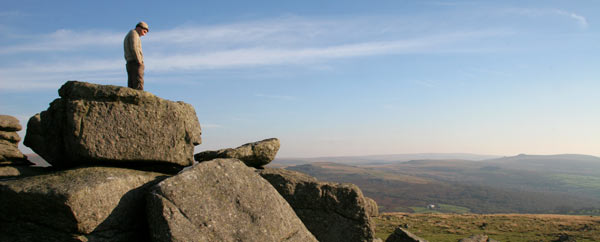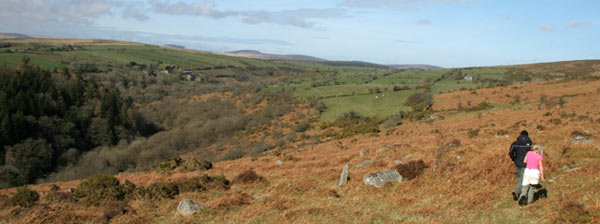
|
|||||||||||
| Activities | |||||||||||
| Farming | |||||||||||
| Attractions | |||||||||||
| Dartmoor | |||||||||||
| Towns | |||||||||||
| Beaches |
Dartmoor - a wonderful place for walking, riding and moutain biking
Dartmoor takes its name from the river Dart which starts as the East and West Dart and becomes one river at the lovely picnic spot of Dartmeet.
Dartmoor covers some 368 square miles and although over half is private land, it was designated as access land in 1985. This means that there are no restrictions as to where walkers can roam, but having said that it is often safer to keep to the 450miles of footpaths and bridleways which cover the moor. Areas to be avoided are the dangerous bogs. Theses are sometimes topped with bright green moss and are known to locals as feather beds because they actually quake beneath your feet!
There is a real wilderness feeling as walk over the moors. When the weather is clear you can see for miles over the surrounding countryside. However the rain can come in very quickly so always take waterproof clothing and it is a very good idea to carry a map and compass as well. The high rainfall does mean there are numerous rivers and streams and these can be quite spectacular after a heavy downpour.
The moorland is capped by exposed granite hilltops known as tors. There are over 160 across the moors and child will love to climb and explore them. It you look carefully amongst the rocks you may well find a waterproof container with a rubber stamp to stamp you're a logbook. This is known as letterboxing and it started on Dartmoor in 1854.
There is plenty of history to be found on Dartmoor and it actually has the largest concentration of Bronze Age remains in the country. The weather then worsened and setlers disappeared from the moors until the medieval period when the weather became warmer again. They also used to natural granite to build their homes but this time in the style of longhouses. Some of these are still inhabited today, whiles others are used as farm buildings but many were abandoned and the ruins of them can be found over the landscape.
As well as sites of habitation you can find many ancient burial sites, stone circles, and stone cross on the moors. These abound with ancient myths and legends.








